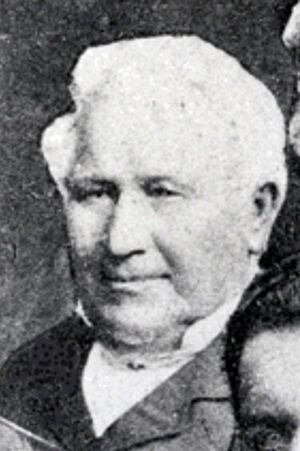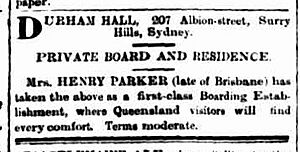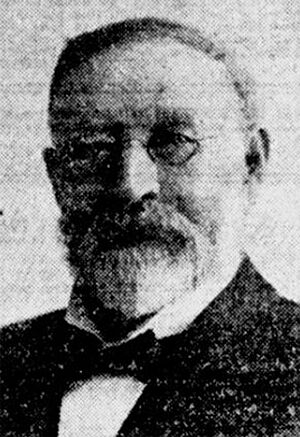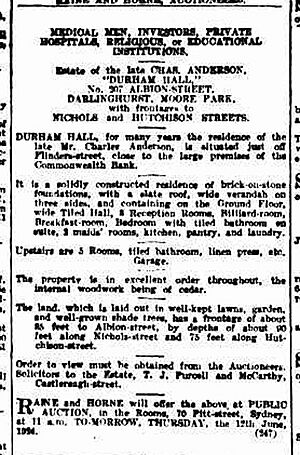Durham Hall, Surry Hills facts for kids
Quick facts for kids Durham Hall |
|
|---|---|

Durham Hall, Surry Hills
|
|
| Location | 207 Albion Street, Surry Hills, City of Sydney, New South Wales, Australia |
| Built | 1834–1835 |
| Built for | George Hill |
| Architectural style(s) | Colonial Georgian |
| Owner | Royal College of Pathologists of Australasia |
| Official name: Durham Hall; Concordia Club; Booker T. Washington Club; Royal College of Pathologists of Australasia | |
| Type | State heritage (built) |
| Designated | 2 April 1999 |
| Reference no. | 221 |
| Type | House |
| Category | Residential buildings (private) |
| Lua error in Module:Location_map at line 420: attempt to index field 'wikibase' (a nil value). | |
Durham Hall is a historic building in Surry Hills, a suburb of Sydney, Australia. It was built between 1834 and 1835. This grand house has been many things over the years. It started as a family home, then became a club for soldiers, and later a German club. Today, it is used as offices.
Durham Hall is also known as the Concordia Club, Booker T. Washington Club, and Royal College of Pathologists of Australasia. It is currently owned by the Royal College of Pathologists of Australasia. This important building was added to the New South Wales State Heritage Register on 2 April 1999.
The house was built in the Colonial Georgian style, which was popular in early Australia. It was made for George Hill, a rich businessman. Over time, the house changed a lot. Many parts were added or changed in ways that didn't fit the original style. By the 1950s, it looked very different. However, in 1983, major work was done to bring it back to its original look. Many of the later additions were removed.
Contents
The History of Durham Hall
Surry Hills: A Growing Suburb
In 1792, Governor Phillip marked the first boundaries of the Sydney settlement. The area where Surry Hills is now was set aside for farming. Land grants were given to military officers and early settlers.
The first land grants in Surry Hills happened in the 1790s. In 1794, Captain Joseph Foveaux received 105 acres. He called it "Surrey Hills Farm." Later, John Palmer bought this land. Due to financial reasons, Palmer's land was sold in 1814. This was the first time land in Surry Hills was divided up for sale.
A few large houses were built in the late 1820s. However, the area was still considered far away from the main town. Surry Hills was a mix of rich merchants' homes and smaller houses for working families.
Later, in the late 1800s and early 1900s, more people moved to Surry Hills. Small factories also started to appear. After World War II, many new migrants came to Surry Hills. In the 1970s and 1980s, more middle-class families moved in.
The Story of Durham Hall
Durham Hall sits on land that was part of a 70-acre grant given to John Palmer in 1794. After the land was divided in 1833, Thomas Broughton bought a part of it. Then, George Hill bought this land and other nearby lots in 1835. He then built Durham Hall.
In 1899, the house was described as being made of brick with a slate roof. It had a hall, eight rooms, a dining room, kitchen, and a servant's room. There was also a separate laundry building and stables. The property also had gardens and yards. Between 1840 and 1850, George Hill built two smaller cottages next to Durham Hall.
George Hill: The First Owner
George Hill was born in 1802 near Parramatta. His parents were convicts. His father became a butcher, and George followed in his footsteps. He became very wealthy by owning his own meat processing business. He also bought several inns and a lot of land.
In 1832, he married Mary Ann Hunter. She was a widow who owned a warehouse. In 1835, George Hill built Durham Hall. A few years after they moved in, his wife Mary Ann died at a young age.
On 24 March 1841, he married Jane Binnie. George and Jane had a very large family. Three of their daughters married into famous families of that time. Mary Jane married Fitzwilliam Wentworth, the son of William Charles Wentworth. Helen Mary married Edward Pomeroy Rundle. Alice Helen married Sir William Charles Cooper.
George Hill became involved in local government. In 1842, he was elected to the Sydney Municipal Council. Two years later, he became a magistrate, which is like a judge. For a short time, he was also a member of the New South Wales Legislative Council. In 1850, he became the Mayor of Sydney.
George Hill died in 1883 at the age of 81 in an accident. His wife Jane continued to live at Durham Hall for six more years. In 1889, she rented the house out as a boarding house. Jane Hill passed away in 1896.
Durham Hall as a Boarding House
Durham Hall was used as a boarding house for ten years, from 1889 to 1899. Mrs. Cecilia Anderson was the first landlady. She ran the boarding house until 1893.
The next landlady was Mrs. Mary Parker. She often advertised in the Sydney Morning Herald newspaper for people to stay there. She even mentioned that the house had a tennis court!
In 1899, Durham Hall was sold to Charles Anderson. This was three years after Mrs. Jane Hill's death.
Charles and Mary Jane Anderson
Charles Anderson was born in Scotland in 1838. He moved to Australia around 1880 with his wife, Mary Jane, and their five children.
He started a big hat factory called Anderson and Co. The factory was a five-story building located right behind Durham Hall. That building has since been taken down and replaced with apartments.
Charles Anderson was also a director of a life insurance company. He was known for being a kind person who gave a lot to charities.
His wife, Mary Jane, died at Durham Hall in 1910. Charles continued to live there until he passed away in 1924. After his death, the property was sold. The advertisement for its sale in 1924 described the house.
Durham Hall as a Club
In 1924, Durham Hall became the German Concordia Club. Over the next ten years, many changes were made to the building. These included adding a bowling alley and a gymnasium. A new front was also built facing the street. The Concordia Club closed in 1939. For a few years after that, a bakers' association used it as a club.
In 1943, the American Red Cross took over the building. They turned it into a club for American servicemen during World War II. They added even more to the building. This club closed after the war. In 1949, The Commonwealth Bank bought the property and made more changes.
In 1979, the National Trust, a group that protects historic places, recognized the property. In 1982, a special order was put in place to protect it.
In 1983, a big restoration project began. Many of the later additions that didn't fit the original style were removed. Before this work, the building was almost unrecognizable. Today, the building is used by the Royal College of Pathologists of Australasia.
What Durham Hall Looks Like
Setting
Durham Hall is an important part of a group of rare Colonial Georgian buildings in Sydney. It shows what a wealthy gentleman's town house looked like long ago. The house helps us understand the first stage of development in Sydney after the early land grants were divided.
A fence with stone pillars surrounds the property. This fence and pillars were built in the 1980s. There is also a garden in front of the house, facing Albion Street. This garden was also recreated in the 1980s to match the old style.
The House Itself
Durham Hall is a two-story house built around 1835. It is made of brick with a stucco (plaster) finish and stone details. It is a classic example of a Colonial Georgian house. The house is built in a balanced, symmetrical way.
There is a verandah (a covered porch) on the ground floor. It wraps around the front and sides of the house. The verandah has Doric columns, which are a type of classical pillar. There are double columns at the main entrance. The roof is sloped (hipped) and covered with slate tiles, which were added in the 1980s.
The windows on the first floor have 12 panes of glass. They are double-hung timber windows in the Georgian style and have shutters. On the ground floor, French doors with shutters are on either side of the main entrance. Another verandah at the back connects the two wings of the house. It opens onto a stone-paved courtyard.
The main structure of the building is original. However, many parts like the roof, windows, and verandah were replaced during the big restoration in the 1980s.
Condition of the House
Inside the house, not many of the original features remain. Some cedar windows are still there. Part of the black and white marble floor in the entrance hall has been uncovered. There are also large stone cellars underground. The separate kitchen building and stables that were once there no longer exist.
The ground around Durham Hall has been changed a lot over the years. Because of these many changes, it's unlikely that digging there would find much useful evidence of how people lived long ago. However, some old things like drains or water tanks might still be hidden.
Changes Over Time
- 1925–1933: The Concordia Club added many parts, including a banquet hall, gymnasium, and bowling alley. They also built a new front for the building in 1933.
- 1949: The Commonwealth Bank changed parts of the building for their use.
- 1959: More parts of the building were taken down or changed.
- 1983: Major restoration work happened. Earlier additions were removed, and many original parts of the house were replaced. Plans for new buildings nearby were also changed to be more respectful of Durham Hall.
- 1987: The garden was rebuilt.
Why Durham Hall is Important
Durham Hall is important because it shows how Surry Hills developed a long time ago. It still has its original two-story Colonial Georgian style. Along with the cottages at 203–205 Albion Street, it helps us see what the street looked like in the past. It is a rare example of a large, two-story middle-class house from that period in inner Sydney.
Durham Hall shows the first stage of Surry Hills' growth and how the early land grants were divided in 1814. Like Cleveland House in Surry Hills, it is one of the few remaining examples of this type of large Colonial Georgian home in the area.
The house is historically important as the home of George Hill, a significant figure in early Sydney. He built the house around 1835 and lived there with his family until he died in 1883. His wife also lived there for some years after his death. So, the Hill family owned the house for over 50 years.
George Hill was a very important person. He was an alderman (a local council member), a magistrate (like a judge), and supported sports. He was born in Parramatta, the son of a convict. He became rich as a butcher and innkeeper. He owned a lot of land in Surry Hills. In 1842, he was elected to the first Sydney Municipal Council. By 1850, he was the Mayor of Sydney. He was known for bringing "dignity and respect" to his roles.
In 1856, Hill was elected to the first New South Wales Legislative Council. He also served on the Committee of the Benevolent Asylum, a charity. The Hill family was connected to other important Sydney families, like the Wentworths and Coopers.
The Concordia Club Ltd. also has a strong connection to Durham Hall. They owned and used the building as their club from 1923 to 1939. It was a place for the German community in Sydney to relax and socialize.
Durham Hall is also linked to the American Red Cross. Between 1943 and 1945, it provided a place for American servicemen of African descent during World War II. This shows how Australia helped support the American forces during the war.
Durham Hall is also beautiful and shows great design. It is a fine example of a Colonial Georgian gentleman's residence. It is similar to Willandra in Ryde and Cleveland House in Surry Hills. Durham Hall shows the balanced and symmetrical style of Colonial Georgian architecture. It is the main building in an important group of Colonial Georgian buildings. This group includes the cottages at 203–205 Albion Street and terraces at 197–201 Albion Street. All of these were originally built for George Hill. They show what the streets looked like in colonial times.
Durham Hall was listed on the New South Wales State Heritage Register on 2 April 1999.
Historical Importance
Durham Hall shows the first stage of Surry Hills' development. It is one of the few remaining examples of large Colonial Georgian homes in the area. It is connected to other smaller Colonial Georgian homes nearby that were also owned by George Hill.
Important People
Durham Hall is strongly linked to George Hill (1802–1883). He was an alderman, magistrate, and supported sports. He became wealthy and was the Mayor of Sydney in 1850. He was known for bringing "dignity and respect" to his roles. His family was connected to other important families like the Wentworths and Coopers.
The Concordia Club Ltd. used Durham Hall as their club from 1923 to 1939. It was a place for the German community in Sydney to socialize.
Between 1943 and 1945, Durham Hall was important for its connection to the American Red Cross. It provided a place for American servicemen of African descent during World War II. This shows Australia's support for the American forces.
Design and Beauty
Durham Hall is a good example of Colonial Georgian architecture, even with the big changes made in the 1980s. Like Willandra and Cleveland House, it shows the balanced and symmetrical style of this architecture. With the cottages at 203-205 Albion Street, it shows Colonial Georgian architecture influenced by different social classes. The building helps us understand what the streets looked like in colonial times.
Research Potential
The ground around Durham Hall has been changed a lot. It is unlikely that digging there would find much useful evidence of how people lived long ago. However, some old things like drains or water tanks might still be hidden. Because of the big restoration, Durham Hall doesn't offer much to learn about how buildings were made in the 1800s.
Rarity
Durham Hall is a rare example of Colonial Georgian style architecture, balance, and planning. It is part of a small group of large, two-story middle-class houses from that period that still exist in Surry Hills, including Cleveland House and Willandra.
Images for kids










